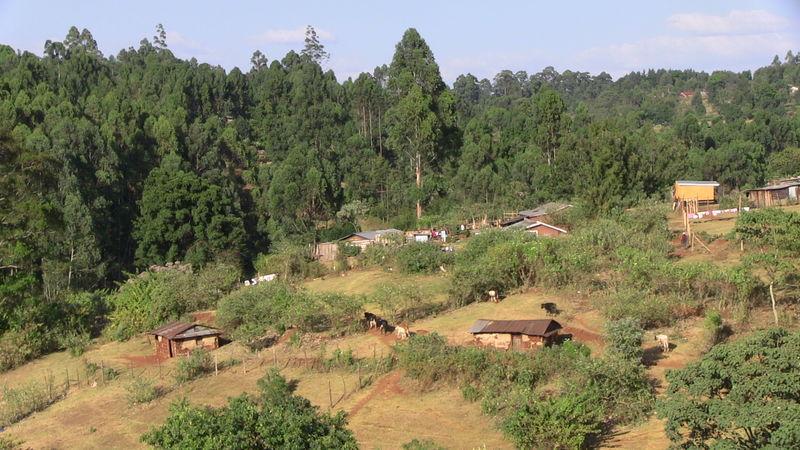Exploitative Cup of Kenyan Tea
This image was taken in January 2017. It shows a crowded settlement area that was allocated to local Kenyans by British colonial government in the 1930s to pave way for tea plantations and control their labor. Due to an increased population and limited land, there has been constant struggle between the locals in tea producing areas in Kenya and the British settlers that own tea estates. The image also shows how the land area has been subdivided into many blocks because of population increase. Cows can be seen roaming around, and it is evident that the settlement was poorly planned and the houses do not look decent. Sadly, adjacent to the settlement is a thriving plantation, ever-green and beautiful tea estates that have positioned Kenya’s tea sector in the global map, thanks in large to the locals for their labor (Swainson, 1977).
Kenya’s tea success story is further blurred with many scenes of exploitation by foreign companies that took advantage of the commodity before the country attained its self-rule. Before independence, tea plantations were owned by British settlers. After independence, local farmers were allowed to plant tea, and Kenya Tea Development Authority (KTDA) - tea body that manages all the tea produced by small scale farmers - has been a key player in managing more than 600, 000 small scale farmers - usually with 3-8 acres of land (Tea Board of Kenya).
My exhibit recognizes the importance of tea sector in Kenya, especially on its contribution to the national economy, and as the main source of labor. However, small scale farmers are still struggling to afford basic needs, and KTDA is rife with corruption. Small-scale farmers are known for producing quality tea, but they are heavily taxed by the government, and their cost of production is high as compared to those of plantations (TBK). Even though small-scale farmers produce quality tea, their produce fetch similar prices in the global. Unlike plantations, the supply chain and marketing channels often benefit big multinational tea corporations, and the local farmers are left behind. Furthermore, small-scale farmers are price takers, owing to their limited participation and lack of influence on policy changes in the sector (van der Wal & Sanne, 2011). On the other hand, the production of tea by the plantations guarantees higher returns because of the limited number of players in the marketing chain, and high level of management. Most of the Kenya tea is exported with little value added resulting in the tea fetching poor prices on the international markets (Ibid.,).
On gender issues, tea production in Kenya has benefitted significantly from women’s labor, especially during the harvesting season. As Collier argues, the role of women in the labor and capital markets is worsened by lack of information about opportunities, an issue that has been blamed on information biases in formal education and agricultural extension; public extension services are dominated by male staff who are more likely to contact male farmers and to target existing growers rather than potential growers (Collier, 1991). Plantations also rely heavily on locals for its daily tea production yet they still fail to treat their workers decently. There has been case of mistreatment, even women claiming that they are subjected to pregnancy tests before they are hired (pregnant women do not get employment if they happen to be pregnant, and their “medical cards would be stamped as ‘unfit’” (Kabiru, 2010).
The uncertainties regarding land tenure and the inadequate access to land have been a critical challenge to smallholder farming in East Africa. The constraints related to the tenure system, such as insecurity of land tenure, unequal access to land, lack of a mechanism to transfer rights and consolidate plots, have resulted in under-developed agriculture, high landlessness, food insecurity, and degraded natural resource (Salami, etl., 2010) Furthermore, the available land in East Africa is overly subdivided into small and uneconomic units, resulting generally in fragmented production systems and low productivity (Ibid.,). As a commodity that was first produced by the British colonial government, the loss of arable land many decades ago by the locals continues to haunt them today. As some scholars have argued, the worsening labor conditions on the settler farms, increasing land shortage due to population pressure in the reserves, and the discriminatory agrarian policies that did not allow the natives to participate in lucrative markets have heard long lasting impacts (Cherry, 1970). Since independence, Kenya’s government is still trying to solve land issues; some locals argue that it is unreasonable to sell land to the people to whom it initially belonged (Gertzel, 1970). Indeed, the British dramatically changed Kenya’s land ownership rights and tea played a key role in the process.

